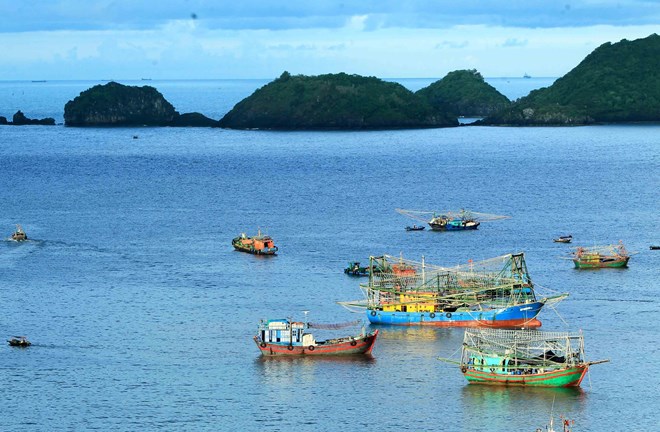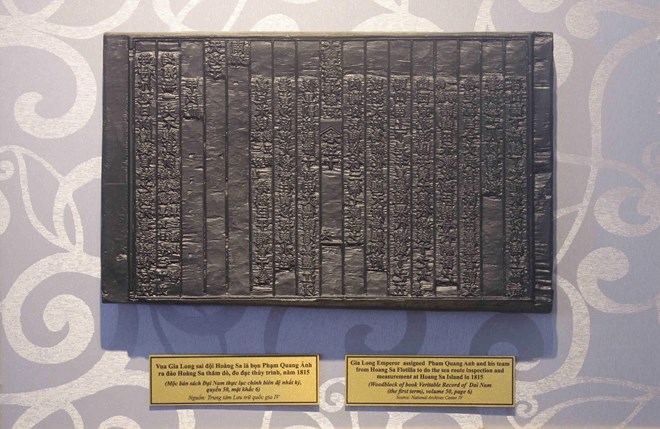
Fishing boats on the waters off the coast of Cat Ba township of Hai Phong city (Photo: VNA)
The East Sea borders Vietnam in the east and the south. Vietnamese people have long called this body of water the “East Sea” because it is east of the country. Hoang Sa and Truong Sa archipelagos are at the centre of this sea, one of the busiest shipping lanes in the world.
Vietnamese history records repeatedly mentioned these chains of islands as indispensable parts of the country’s territory and territorial sea such as “Phu bien tap luc” (Miscellaneous chronicles of the pacified frontier) by Le Quy Don in 1776, “Thien Nam tu chi lo do thu” (Collection of the South’s Road Map) by Do Ba in the mid-17th century, and “Lich trieu hien chuong loai chi” (A classified treatise of the institutions of successive dynasties) by Phan Huy Chu in the early 19th century.
This fact can also been seen in official history and geography records of the Nguyen Dynasty (1802 – 1945), including “Dai Nam thuc luc” (Chronicle of Dai Nam – an old name of Vietnam), “Dai Nam nhat thong chi” (Unification records of Dai Nam), and “Dai Nam dia du chi” (Geographical record of Dai Nam).
Notably, there are many documents recording the Nguyen Dynasty’s territorial expansion and establishment and exercising of sovereignty over Hoang Sa and Truong Sa. They include the dynasty’s woodblocks and imperial archives which have been recognised as world documentary heritage by UNESCO.

A plate of the Nguyen Dynasty's woodblocks affirming Vietnam's sovereignty over Hoang Sa archipelago (Photo: VNA)
Of the woodblocks, there are plates recording historical events of the Nguyen Lords from 1558 to 1777.
Plate No. 24 inscribed with part of the 10th volume of “Dai Nam thuc luc tien bien” (Early Chronicle of Dai Nam) says: “In the sea off the coast of Vinh An commune of Binh Son district, Quang Ngai province, there are more than 130 sand banks … stretching for several thousands of miles called Van ly Hoang Sa – the eternal yellow sand bank. On these sand banks, there are fresh water and seafood like sea cucumber and hawksbill turtle… In the early period of the dynasty, a Hoang Sa flotilla was set up with 70 members from An Vinh commune. Every year, they begin sailing in March and reach the bank in about three days to seek natural produce and then return to hand over the produce in August.”
Director of the National Archives of Vietnam Dang Thanh Tung said the Hoang Sa flotilla, formed in the era of the Nguyen Lords, is a unique way to establish and exercise the country’s sovereignty over Hoang Sa archipelago. This flotilla’s trips to Van ly Hoang Sa were annual activities.
Notably, in 1816, King Gia Long ordered the erection of markers and flags affirming sovereignty in Hoang Sa.
The dynasty’s imperial archives also show the Nguyen kings always paid attention to the establishment and exercising of sovereignty in the East Sea, especially Hoang Sa and Truong Sa archipelagos and onshore islands like Con Dao and Phu Quoc.
According to these archives, the kings sent people to make surveys, plant markers and draw maps, and save Vietnamese and foreign boats in distress in waters surrounding Hoang Sa and Truong Sa.
Apart from domestic historical records, many maps published by other countries also prove Vietnam’s sovereignty over these two archipelagos. They include “An Nam dai quoc hoa do” (Map of the Great An Nam – another old name of Vietnam), an appendix of Dictionariumlatino-anamiticum (Latin-An Nam dictionary) published by Oriental Lith. Press in Calcutta, India, in 1838. This map features a group of islands at the centre of the East Sea with the Latin note “Paracel seu Cat Vang”, which means “Paracel or Cat Vang”.
According to the article “Note on the Geography of Cochinchina” on The Journal of the Asiatic Society of Bengal, published in Calcutta in 1837, Bishop Jean Louis Taberd, also the author of Dictionariumlatino-anamiticum, wrote that for the last 34 years, Paracel, called Cat Vang – Hoang Sa by Vietnamese people, had been occupied by Vietnamese people in Dang Trong (the region that comprised the central and southern regions of Vietnam nowadays). He added that in 1816, King Gia Long sent people to plant a flag and declare the sovereignty over these banks.
A map drawn by Jodocus Hondius in 1613 also shows Hoang Sa archipelago and all islands of Vietnam from the south of the Gulf of Tonkin to the end of the country’s southern waters, except for Pulo Condor (Con Dao) and Pulo Cici (Phu Quoc) drawn separately.
The Journal of an Embassy from the Governor-General of India to the Courts of Siam and Cochin China, compiled by John Crawfurd and published in London (the UK) in 1830, also wrote: “The King of Cochin China, in 1816, took possession of the uninhabited and dangerous archipelago of rocks, islets, and sand banks, called the Paracels, which he claims as part of his dominions, and over which his authority is not likely to be disputed.”
From September 4 to 8, 1951, a conference was held in San Francisco, the US, to discuss the signing of a peace treaty with Japan, gathering representatives of 51 countries. A delegation of the State of Vietnam (1949 – 1955), a member of the French Union at that time, led by Prime Minister and Foreign Minister Tran Van Huu of former King Bao Dai’s government attended the event.
At that conference, Huu reaffirmed the country’s long-standing sovereignty over Hoang Sa and Truong Sa archipelagos in front of 51 diplomatic delegations. This declaration did not meet any protests from participating countries./.
VNA
 Vietnamese men’s national football team moves to 110th in FIFA rankings
Vietnamese men’s national football team moves to 110th in FIFA rankings




